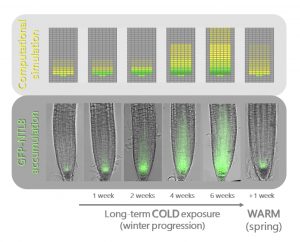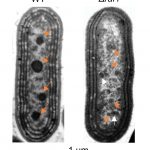Temperature-dependent growth contributes to long-term cold sensing ($) (Nature)

Seasonal changes in ambient temperature greatly influence plant development. While the response to acute heat stress has been widely studied, the regulatory mechanisms that integrate naturally fluctuating temperatures – such as the progression of winter – remain largely unknown. This paper sheds new light on the activation of VERNALIZATION INSENSITIVE 3 (VIN3), a key regulator of the response to long-term cold exposure in Arabidopsis. Zhao and colleagues mutagenized a reporter line carrying VIN3 fused to LUCIFERASE (in vin3-6 background) and identified dominant mutations in NTL8, encoding a membrane-associated NAC transcription factor, with altered VIN3-LUC expression patterns. The analysis of multiple GFP–NTL8 reporter lines indicated that the fluorescence signal increased gradually in root meristems in response to cold conditions and decreased in post-cold warm conditions. Rather than changes in transcript levels, low protein turnover contributed to NTL8 accumulation during vernalization, and consequently a progressive increase of VIN3 expression. Modeling combined with experimental validation demonstrated that growth-dependent protein dilution determined NTL8 accumulation: faster growth at warm temperatures associated with lower NTL8 amounts, whereas slower growth at low temperatures with higher NTL8 amounts. Similar patterns were also observed in plants subjected to non -cold treatments affecting plant development: lower NTL8 concentrations upon treatment with growth-promoting hormones, and higher NTL concentrations with growth inhibiting compounds. To conclude, seasonal changes can be sensed through indirect mechanisms relying on protein dilution mediated by temperature-dependent growth. This long-term temperature-sensing system can be applied to other long-lived proteins with a constant production and slow degradation. (Summary and image modification by Michela Osnato @michela_osnato) Nature 10.1038/s41586-020-2485-4



